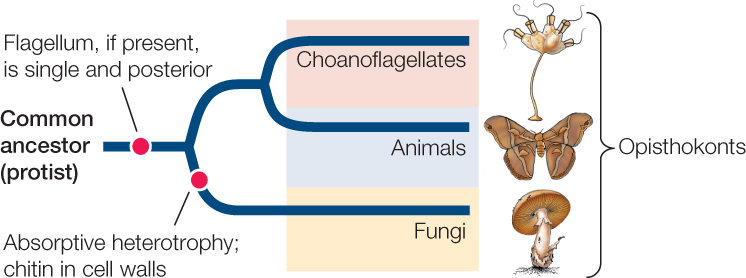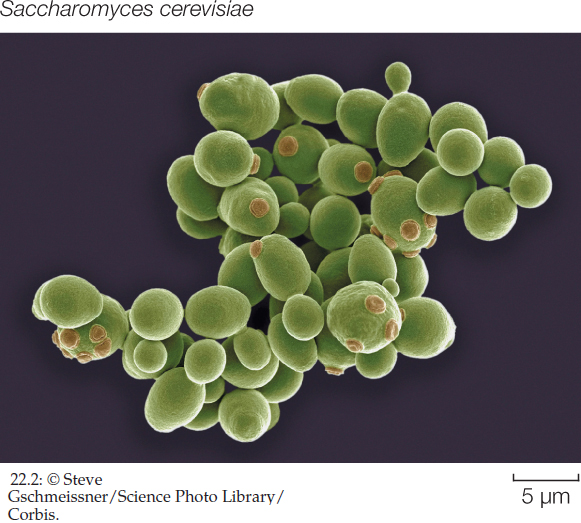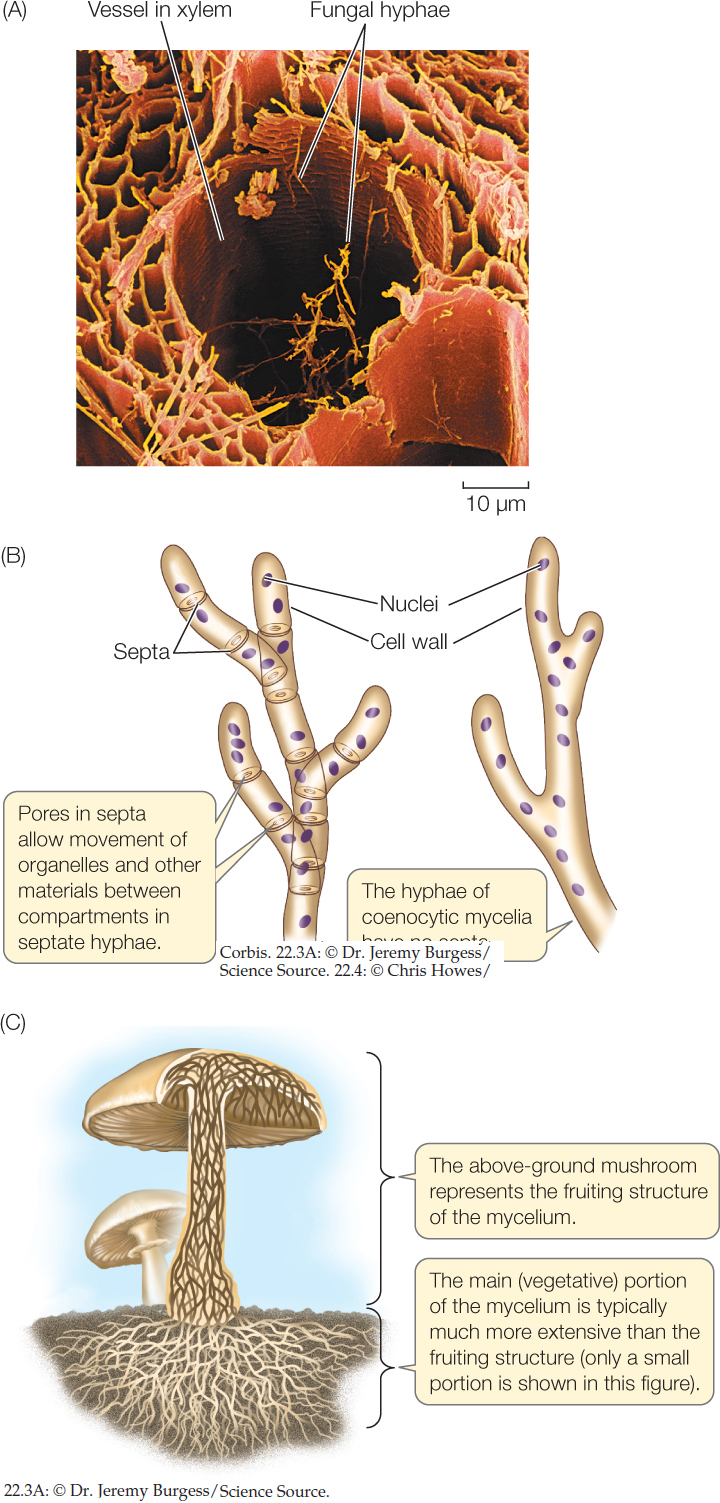Concept 22.1: Fungi Live by Absorptive Heterotrophy
Fungi are organisms that digest their food outside their bodies. They secrete digestive enzymes to break down large food molecules in the environment, then absorb the breakdown products through their cell membranes in a process known as absorptive heterotrophy. This mode of nutrition is successful in a wide variety of environments. Many fungi are saprobes, meaning they absorb nutrients from dead organic matter. Others are parasites, absorbing nutrients from living hosts. Still others are mutualists, living in intimate associations with other organisms that benefit both partners.
Modern fungi are believed to have evolved from a unicellular protist ancestor that had a flagellum. The probable common ancestor of the animals was also a flagellated protist much like the living choanoflagellates (see Figure 23.2). Current evidence, including the sequences of many genes, suggests that the fungi, choanoflagellates, and animals share a common ancestor not shared by other eukaryotes. These three lineages are often grouped together as the opisthokonts (FIGURE 22.1). A synapomorphy (shared derived trait) of the opisthokonts is a flagellum that, if present, is posterior, as in animal sperm. The flagella of all other eukaryotes are anterior.

Synapomorphies that distinguish the fungi as a group among the opisthokonts include absorptive heterotrophy and the presence of chitin, a structural polysaccharide, in their cell walls. The fungi represent one of four independent evolutionary origins of large multicellular organisms (plants, brown algae, and animals are the other three).
Unicellular yeasts absorb nutrients directly
Most fungi are multicellular, but single-celled species are found in most fungal groups. Unicellular, free-living fungi are referred to as yeasts (FIGURE 22.2). Some fungi that have yeast life stages also have multicellular life stages. Thus the term “yeast” does not refer to a single taxonomic group, but rather to a lifestyle that has evolved multiple times. Yeasts live in liquid or moist environments and absorb nutrients directly across their cell surfaces.

The ease with which many yeasts can be cultured, combined with their rapid growth rates, has made them ideal model organisms for study in the laboratory. They present many of the same advantages to laboratory investigators as do many bacteria, but because they are eukaryotes, their genome structures and cells are much more like those of humans and other eukaryotes than are those of bacteria.
LINK
You can read about other model organisms in Concept 12.3
Multicellular fungi use hyphae to absorb nutrients
The body of a multicellular fungus is called a mycelium (plural mycelia). A mycelium is composed of a mass of individual tubular filaments called hyphae (singular hypha; FIGURE 22.3A), in which absorption of nutrients takes place. The cell walls of the hyphae are greatly strengthened by microscopic strands of a complex polysaccharide called chitin. In some species of fungi, the hyphae are subdivided into cell-like compartments by incomplete cross-walls called septa (singular septum). These subdivided hyphae are referred to as septate hyphae. Septa do not completely close off compartments in the hyphae. Pores at the centers of the septa allow organelles—sometimes even nuclei—to move in a controlled way between compartments (FIGURE 22.3B). In other species of fungi, the hyphae lack septa but may contain hundreds of nuclei. These multinucleate, undivided hyphae are referred to as coenocytic. The coenocytic condition results from repeated nuclear divisions without cytokinesis.

Certain modified hyphae, called rhizoids, anchor some fungi to their substrate (i.e., the dead organism or other matter on which they are feeding). These rhizoids are not homologous to the rhizoids of plants, and they are not specialized to absorb nutrients and water.
Fungi can grow very rapidly when conditions are favorable. In some species, the total hyphal growth of a fungal mycelium (not the growth of an individual hypha) may exceed 1 kilometer a day! The hyphae may be widely dispersed to forage for nutrients over a large area, or they may clump together in a cottony mass to exploit a rich nutrient source. The familiar mushrooms you may notice growing in moist areas are spore-producing fruiting structures (FIGURE 22.3C). In the fungal species that produce these structures, the mycelial mass is often far larger than the visible mushroom. The mycelium of one individual fungus discovered in Oregon covers almost 900 hectares underground and weighs considerably more than a blue whale (the largest animal). Aboveground, this individual is evident only as isolated clumps of mushrooms.
452
Fungi are in intimate contact with their environment
The filamentous hyphae of a fungus give it a unique relationship with its physical environment. The fungal mycelium has an enormous surface area-to-volume ratio compared with that of most large multicellular organisms. This large ratio is a marvelous adaptation for absorptive heterotrophy. Throughout the mycelium (except in fruiting structures), all of the hyphae are very close to their food source.
The downside of the large surface area-to-volume ratio of the mycelium is its tendency to lose water rapidly in a dry environment. Thus fungi are most common in moist environments. You have probably observed the tendency of molds, toadstools, and other fungi to appear in damp places.
Another characteristic of some fungi is a tolerance for highly hypertonic environments (those with a solute concentration higher than their own; see Concept 5.2). Many fungi are more resilient than bacteria in hypertonic surroundings. Jelly in the refrigerator, for example, will not become a growth medium for bacteria because it is too hypertonic to those organisms, but it may eventually harbor mold colonies. Mold in the refrigerator illustrates yet another trait of many fungi: tolerance of temperature extremes. Many fungi grow in temperatures as low as −6°C, and some tolerate temperatures higher than 50°C.
CHECKpoint CONCEPT 22.1
- Describe the relationship between fungal structure and absorptive heterotrophy.
- What are the advantages and disadvantages to multicellular fungi of the large surface-to-volume ratio of the mycelium?
Fungi are important components of healthy ecosystems. They interact with other organisms in many ways, some of which are harmful and some beneficial to those other organisms.